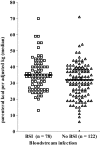The risk for bloodstream infections is associated with increased parenteral caloric intake in patients receiving parenteral nutrition
- PMID: 17958913
- PMCID: PMC2556767
- DOI: 10.1186/cc6167
The risk for bloodstream infections is associated with increased parenteral caloric intake in patients receiving parenteral nutrition
Abstract
Background: Patients receiving total parenteral nutrition (TPN) are at high risk for bloodstream infections (BSI). The notion that intravenous calories and glucose lead to hyperglycemia, which in turn contributes to BSI risk, is widely held but is unproven. We therefore sought to determine the role that hyperglycemia and parenteral calories play in the development of BSI in hospitalized patients receiving TPN.
Methods: Two hundred consecutive patients initiated on TPN between June 2004 and August 2005 were prospectively studied. Information was collected on patient age, sex, admission diagnosis, baseline laboratory values, intensive care unit (ICU) status and indication for TPN. Patients in the ICU were managed with strict glycemic control, whereas control on the general ward was more liberal. The maximum blood glucose level over each 8-hour period was recorded, as were parenteral daily intake, enteral daily intake and total daily caloric intake. The primary outcome measure was the incidence of BSI. Additional endpoints were ICU length of stay, hospital length of stay and mortality.
Results: A total of 78 patients (39%) developed at least one BSI, which were more common in ICU patients than in other hospitalized patients (60/122 patients versus 18/78 patients; P < 0.001). Maximum daily blood glucose concentrations were similar in patients with BSI and in patients without BSI (197 mg/dl versus 196 mg/dl, respectively). Patients with BSI received more calories parenterally than patients without BSI (36 kcal/kg/day versus 31 kcal/kg/day, P = 0.003). Increased maximum parenteral calories, increased average parenteral calories, and treatment in the ICU were strong risk factors for developing BSI. There was no difference in mortality between patients with and without BSI.
Conclusion: Increased parenteral caloric intake is an independent risk factor for BSI in patients receiving TPN. This association appears unrelated to hyperglycemia. Based upon our observations, we suggest that parenteral caloric intake be prescribed and adjusted judiciously with care taken to account for all intravenous caloric sources and to avoid even short periods of increased intake.
Figures




Comment in
-
Too much of a good thing: the curse of overfeeding.Crit Care. 2007;11(6):176. doi: 10.1186/cc6165. Crit Care. 2007. PMID: 18036266 Free PMC article. Review.
References
-
- Heyland DK, Montalvo M, MacDonald S, Keefe L, Su XY, Drover JW. Total parenteral nutrition in the surgical patient: a meta-analysis. Can J Surg. 2001;44:102–111. - PubMed
-
- Moore FA, Feliciano DV, Andrassy RJ, McArdle AH, Booth FV, Morgenstein-Wagner TB, Kellum JM, Jr, Welling RE, Moore EE. Early enteral feeding compared with parenteral, reduces postoperative septic complications: the results of a meta-analysis. Ann Surg. 1992;216:172–183. doi: 10.1097/00000658-199208000-00008. - DOI - PMC - PubMed
MeSH terms
Substances
LinkOut - more resources
Full Text Sources
Medical
Research Materials

